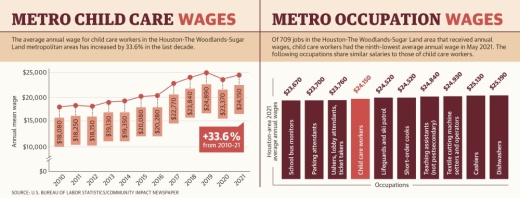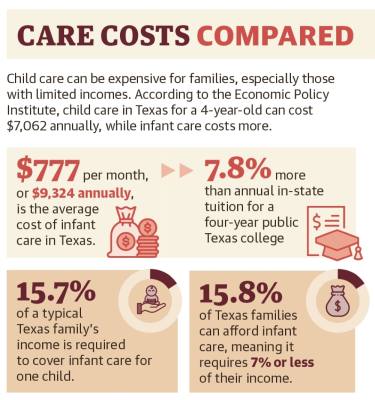According to the U.S. Department of Health and Human Services, child care is considered unaffordable if it requires over 7% of a family’s income. As of October 2020, the typical Texas family was paying 15.7% of its income for infant care for one child, according to the Economic Policy Institute. By this standard, 15.8% of families could afford infant care.
Spring-area parent Amber Naylor has two daughters, ages 8 and 5, who both receive child care services since Naylor and her husband both work full-time jobs. Child care is a big expense compared to the family’s other bills, Naylor said, even though the day cares they use have not increased tuition during the pandemic.
“One child in full-time day care is the cost of a monthly mortgage payment for us. ... If we’re talking car payments, this is easily two car payments for the one child in day care,” Naylor said.
With the 88th Texas Legislature set to begin Jan. 10, many parents are looking to local legislators for assistance facing the rising cost of child care. In an email June 23, state Rep. Sam Harless, R-Spring, said child care costs are “eating up a larger portion of income” for families with children. However, he added more research may be needed before state legislators consider providing families or child care centers with additional funding.
“We are hearing more requests and higher demand for increased state funding in a number of areas. ... In the end, it will likely come down to available budget dollars,” Harless said.
Sara Ray, the director of Kinsmen Children’s Academy in Spring, said the coronavirus pandemic has proven to be a challenge for early childhood education.
“We have not raised our prices in quite a while, but we will need to raise prices soon in order to continue to offer high-quality care with the rising prices of supplies, utilities and to keep our staff wages competitive,” Ray said.
While the pandemic has proven to be a challenge for both child care centers and parents alike, individuals on both sides are now seeking solutions.
Increasing costs
As of October 2020, the average cost of infant care in Texas was $777 per month, or $9,324 annually—7.8% more expensive than the annual in-state tuition for a four-year public college in Texas, according to the Economic Policy Institute. Meanwhile, the average cost of child care for a 4-year-old is $589 per month, or $7,062 annually.
According to the U.S. Bureau of Labor Statistics’ consumer price index—a measure of the average change in prices—the cost for day care and preschool rose 3.2% nationally from May 2021 to May 2022.
While parents are spending more on child care than they were two years ago, child care centers are also facing higher costs and other industry issues related to the economic downturn.
Larry Drown, the owner and director of Campus Kids—a before- and after-school and summer camp program in partnership with Klein ISD—said he may have to consider raising his rates for the first time in five years due to inflation.
“In summer camp, I do a morning snack and ... an afternoon snack, and so if I take one item for an example, ... the chips have gone from 25 cents a bag to 37 cents a bag. ... If you do it over the school year, it’s about $48,000 [more],” Drown said.
About 21% of child care centers in Texas had closed due to financial hardships induced by the pandemic as of September 2021, said Kim Kofron, the director of early childhood education with Texas-based nonprofit Children at Risk. Kofron said these closures further exacerbated child care deserts, or ZIP codes with fewer than 36 child care seats per 100 children of working parents.
While most ZIP codes in the Spring area meet CAR’s standards, 77069 falls below with 15-25 seats for every 100 children as of February. Of the child care deserts in the North Houston area, including Spring, about 80% are Texas Rising Star child care deserts, Kofron said, which means they are not quality controlled by the state.
“On a whole, ... [Spring-area child care centers] are doing better than the state average,” Kofron said.
Staffing challenges
The child care industry, like other industries, is also facing a shortage of qualified workers, Ray said.
“Our enrollment dropped for quite a while, and we’ve been able to rebuild just recently,” Ray said. “We’ve also struggled with staff—both keeping them healthy and keeping them here.”
A survey released in February by the National Association for the Education of Young Children reported two-thirds of child care centers in the U.S. are experiencing a staffing shortage. A September 2021 NAEYC survey reported 86% of child care centers in Texas saw staffing shortages; 79% of those surveyed identified wages as the main recruitment challenge.
In May 2021, the Bureau of Labor Statistics reported the average annual wage for a child care worker in the Houston-The Woodlands-Sugar Land metropolitan area was $24,150—the ninth lowest-paying occupation out of the 709 occupations in the region that receive an annual wage.
Resources and funding
On June 14, the Harris County Commissioners Court approved the use of $48 million in American Rescue Plan Act funds for a new child care and early childhood development program, which aims to increase the accessibility of child care in Harris County by 10%.
“Early childhood programs have one of the strongest returns on investment of any type of public program,” Harris County Judge Lina Hidalgo said. “Those positive effects also endure throughout the child’s life.”
According to a June 13 news release, the program will be a three-year pilot that will create more child care options for children age 3 and younger in Harris County communities with less opportunities. Funds will also be allocated to provide child care workers with better wages and to help child care centers recover from pandemic-induced economic hardships.
At the federal level, Early Head Start and Head Start offer low-income families free early educational opportunities and services. Local Head Start centers include Spring ISD’s Bammel and Eickenroht elementary schools, while the Oakwood Avance Center offers both programs.
Additionally, SISD’s 21st Century Program offers free after-school care and summer camps for K-12 students attending specific SISD campuses.
In partnership with KISD, Drown said Campus Kids offers scholarships on a case-by-case basis to aid military families and families experiencing financial hardships.
Additionally, an initiative through the American Rescue Plan Act offered to aid families during the pandemic was the 2021 Advance Child Tax Credit payment, which allowed parents to receive an average $250-$300 monthly payment per child starting July 15, 2021, according to the Internal Revenue Service.
Kofron said she hopes to see state and federal legislators continue to invest in child care in the future.
“We really want to make sure that as we plan into next year as when those funds run out that there’s some mechanisms in place to make sure that the bottom doesn’t fall out,” Kofron said.
Ally Bolender contributed to this report.







